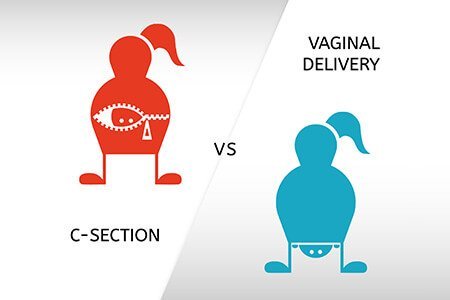Delivery or childbirth
Delivery – Methods, risks, complications, hospitalization and costs
Things you need to know about Delivery or childbirth
Delivery refers to the process of giving birth to a child. In the lack of adequate medical facilities, the deliveries in the older times were done at home, often in the presence of midwife or dai. With the medical advancement, even the most complicated deliveries are now conducted with great safety and convenience at multispecialty hospitals, where all the facilities for the mother as well as the child care are available. The current practice aims to make the transition from ‘being pregnant’ to ‘being a mother’ as smooth and convenient as possible.

Delivery and Childbirth
What are the types of delivery?
In majority of cases, delivery or childbirth happens naturally i.e., through the vaginal route. However, in certain conditions or emergency situations, it may be done surgically via a Cesarean section.
Vaginal delivery (Normal delivery)
The natural, most common and safest method of childbirth is the vaginal delivery. In many cases, the delivery does not require any major intervention by the doctor. However, sometimes the gynaecologist/obstetrician may use special instruments like forceps (similar to large spoons) to guide the movement of the baby through the birth canal by cupping the head. Alternately, suction cup may be used, if required, to gently pull the baby out from the birth canal.
Cesarean birth/C-section
Sometimes, a vaginal delivery may not be possible because of some complications. In such cases, the obstetrician conducts the delivery surgically, by making a cut in the belly of the mother and the uterus. Cesarean section nowadays is a commonly conducted and safe procedure. In most cases, a C-section doesn’t require general anaesthesia and epidural or spinal anaesthesia (an injection in the lower back where only the lower portion of the body is numbed) is adequate. A C-section is carried out by a trained obstetrician, with the help of an anaesthetist and trained nursing and operation theatre staff. Generally, a neonatologist also attends the procedure.

Cesarean delivery Vs Normal Delivery
When is a Cesarean section advised?
A Cesarean section is advised as a planned mode of delivery in case some issues are identified beforehand. Some of the reasons include:
- Position of the baby is not as expected around the due date, i.e., head down.
- Medical issues with the mother which may be risky for the mother or the baby like, heart disease, infections, etc.
- Multiple pregnancy or more than one baby (twins or triplets).
- Previous history of Cesarean section which doesn’t allow a vaginal delivery to be attempted.
However, in many cases, a decision to undertake Cesarean section may be taken while the patient is in labour pain. Such unplanned Cesarean section is advised due to reasons such as:
- Risk to the baby by a peculiar positioning of the placenta or the umbilical cord
- Signs of distress of the baby like a very fast or slow heart rate
- Slow, hard labour
Can a normal/vaginal delivery be conducted if a woman has undergone Cesarean section during the previous delivery?
Depending upon the reason for previous Cesarean section as well as the type and position of the cut made during the previous Cesarean section, the gynaecologist/obstetrician may determine if it is safe to go ahead for a vaginal delivery for the current pregnancy. It is always best to consult the attending obstetrician and follow their advice in these matters.
What are the risks and complications of Cesarean section?
Cesarean section is routinely a safe procedure and majority of mothers and babies perform well after Cesarean section. However, being a surgery, there might be certain risks which include:
- Infection at the surgical site, i.e., the incision or the uterus
- High blood loss
- Blood clot formation in the lungs or legs of the mother
- Surgical injury to the mother or baby
- Side effects or complications of anaesthesia, like nausea, vomiting, and severe headache
- Scar formation in the uterus
How to prepare yourself for delivery ?
While the time before delivery is among the most anxious situations in life, it is best to relax and mentally prepare yourself for motherhood.
Before delivery:
- Keep all your medical records – personal and pregnancy records in hand. Discuss with your doctor regarding the medicines and vaccinations.
- For the due day and hospital visit: Pack loose clothing, bathrobe, socks and woolen, blankets, for you and baby. A relaxing kit such as book, music, along with snacks. Once the baby is born you will need nursing bras, swaddling cloth, maternity wear and a going home outfit. Keep jewelry and lots of cash safely at home.
- If your blood group is negative, consult with the doctor for Anti-D medicines. This must be taken during pregnancy or at least immediately after delivery.
- Health conditions such as gestational diabetes (high blood sugar during pregnancy), preeclampsia (high blood pressure during pregnancy), and heart diseases increase the chances of high-risk pregnancies. Consult your doctor and follow necessary precautions.
- Identify the signs of labor such as rupture of membrane, bleeding or spotting, pain associated with contractions. Your baby is on the way, consult your doctor.
After delivery:
- Depending upon the mode of delivery, if you undergo any health issues, the gynaecologist/obstetrician will give specific instructions for recovery.
- The incision after a cesarean section requires time to heal. It is best to relax and avoid heavy lifting, intense exercise, and sit-ups.
- If possible, arrange for someone to help you with childcare, housework, cooking and other such activities.
- You may experience some pain in the belly area and may need medications as per your obstetrician advice.
- Give yourself some time to recover from delivery before you venture into fitness and full blown exercise regimen. First, let your body heal and then when you are ready begin with small steps and short-term goals.
How to decide on the best hospital for delivery?
Let the transition from pregnancy to motherhood be as smooth as possible. Such an experience requires a therapeutic yet holistic approach with not only the best gynaecologist/obstetrician and paediatrician, but also a compassionate team of nurses, lactation consultants, and counsellors.

How to decide on the best hospital for delivery?
- Do not choose a new hospital for delivery. Look for hospitals that offer best facilities with a highly qualified and experienced team of obstetricians, neonatologists/paediatricians/anaesthesiologists/nurses and allied staff.
- Check with your insurance provider if you are eligible for the coverage. Make sure the hospital is covered under your insurance plan.
What is the cost for delivery in Hyderabad?
The cost of delivery depends on the type of delivery, i.e., vaginal or Cesarean section. The actual cost might vary depending upon:
- Presence of other health complications
- Hospital infrastructure and technology used
- Availability of experienced gynaecologists/obstetricians and advanced techniques
- Length of hospital stay and category of room opted
To know more about delivery options, you can request for a call back and our specialists will call you and answer all your queries.
References
- Mayo Clinic. Labor and delivery, postpartum care. Available at:https://www.mayoclinic.org/healthy-lifestyle/labor-and-delivery/basics/labor-and-delivery/hlv-20049465. Accessed on 23rd December 2017.
- Mayo Clinic. C-section. Available at: https://www.mayoclinic.org/tests-procedures/c-section/basics/definition/prc-20014571.Accessed on 23rd December 2017.
- Mayo Clinic. Vaginal birth after C-section (VBAC). Available at: https://www.mayoclinic.org/tests-procedures/vbac/in-depth/vbac/art-20044869.Accessed on 23rd December 2017.
- American Academy of Pediatrics. Preparing for Delivery. Available at: https://healthychildren.org/English/ages-stages/prenatal/Pages/Preparing-for-Delivery.aspx. Accessed on 23rd December 2017
Disclaimer:
“The content of this publication has been developed by a third party content providerwho are clinicians and/or medical writers and/or experts. The information contained herein is for educational purpose only and we request you to please consult a Registered Medical Practitioner or Doctor before deciding the appropriate diagnosis and treatment plan.”



 Appointment
Appointment Second Opinion
Second Opinion WhatsApp
WhatsApp Call
Call More
More





